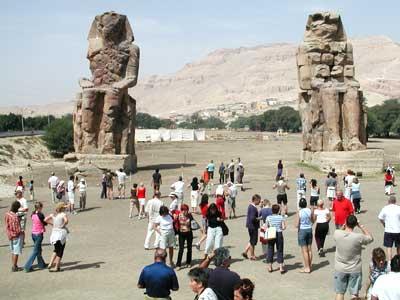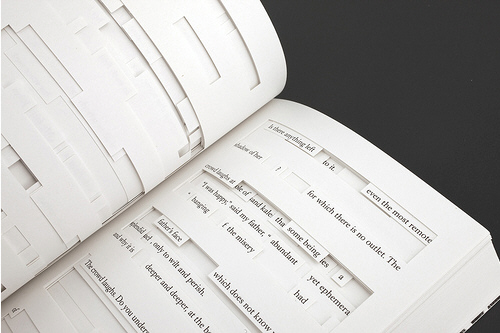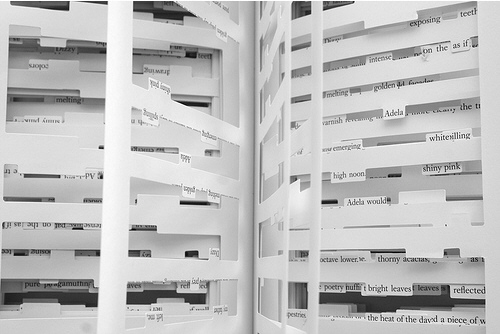Oficina Miríade
Blog
O Templo mortuário de Amenhotep III

Colossi de Memnon, os vestígios mais visíveis do Templo mortuário de Amenhotep III
Amenhotep (ou Amenófis) III foi um dos faraós mais importantes da 18ª Dinastia egípcia, durante seu reino – entre 1388 a.C. e 1350 a.C., aproximadamente – a civilização egípcia viveu seu auge político e cultural. Uma curiosidade: Amenhotep III é avô de Tutankhamun (ou Tutancâmon).
Considerado um dos maiores e mais importantes monumentos mortuários existentes no Egito, o Templo mortuário de Amenhotep III integrou a lista de monumentos culturais ameaçados do World Monuments Fund (The Watch) por duas vezes, em 1998 e 2004.
Desde 1997, está em andamento um programa de preservação de longo prazo desse importante sítio arqueológico. A missão arqueológica, chefiada por Hourig Sourouzian, pretende recuperar objetos relacionados ao Templo e conservar o que restou das ruínas.
Hourig Sourouzian, chefe da missão arqueológica do Templo mortuário de Amenhotep III, fala sobre o monumento, direto de Luxor (vídeo do Heritage Key)
A descoberta mais recente (divulgada em 26/04/2011) foi uma nova estátua de Amenófis III, segundo comunicado pelo secretário de Estado para as Antiguidades, Zahi Hawass. Trata-se de uma das maiores estátuas de faraó encontradas até hoje.
Saiba mais:
– Amenhotep III, Digital Egypt for Universities
– Amenhotep III , BBC History
– Artigo de Hourig Sourouzian: Beyond Memnon – Buried for more than 3,300 years, remnants of Amenhotep III’s extraordinary mortuary temple at Kom el-Hettan rise from beneath the earth
– The mortuary temple of Amenhotep III, World Monuments Fund
– Mortuary Temple of Amenhotep III>, Heritage Key
– Saving Pharaoh Amenhotep III’s Funerary Temple at Thebes, Heritage Key
– Egito: Encontrada estátua colossal do faraó Amenófis III, Yahoo! Notícias
– Statue of Tutankhamun’s grandfather unearthed, The Guardian
Escrito por Laura Klemz Guerrero em 26 de abril de 2011
escreva um comentário · link deste post
Tags: Amenhotep III · Amenófis III · arqueologices · Egito · Hourig Sourouzian · Kom al Hitan · Kom el-Hettan · Luxor · Tebas · Templo mortuário de Amenhotep III · Zahi Hawass
Exposição – Monstros: Memórias da ciência e fantasia

Besta africana, imagem do livro Monstrorvm Historia, presente na exposição Monstros
Está em cartaz até o dia 5 de maio, na Divisão de Obras Raras da Biblioteca Nacional, uma exposição de livros raros que incluem representações iconográficas de monstros.
O tema, aparentemente banal, requereu a busca em diferentes registros de distintas áreas de conhecimento (Medicina, Relatos de Viagens, História, Geografia, Poesia, Biologia, Biografias, Estudos da Natureza, Ecologia e Biodiversidade), oferecendo 16 livros e 12 imagens, dos séculos XVI a XIX, sobre criaturas cuja existência é sugerida, sobre animais fabulosos e sobre pessoas com anomalias que eram interpretadas como monstruosidades – a maioria de significativa ocorrência no imaginário popular.
Veja o catálogo da exposição Monstros: Memórias da ciência e fantasia.
Exposição Monstros: Memórias da ciência e fantasia
Quando: prorrogada até 5 de maio; de segunda à sexta, das 10h às 16h.
Onde: Biblioteca Nacional – Divisão de Obras Raras
Av. Rio Branco, 219 / 3º andar, Rio de Janeiro, RJ. Metrô: Cinelândia, saída Pedro Lessa.
Quanto: entrada franca
Mais informações: http://www.bn.br/portal/index.jsp?nu_padrao_apresentacao=25&nu_item_conteudo=1382&nu_pagina=1
Escrito por Laura Klemz Guerrero em 15 de abril de 2011
escreva um comentário · link deste post
Tags: acervo raro · Biblioteca Nacional · exposições · Monstros: Memórias da ciência e fantasia
Tree of codes @ Visual editions
Tree of codes é um novo livro de Jonathan Safran Foer – autor de Tudo se ilumina (que virou filme) e Extremamente alto e incrivelmente perto (adoro esse título).
Trata-se de um livro-escultura, elaborado em parceria com a Visual editions, onde cada página foi recortada com moldes diferentes, característica que tornou sua produção um grande desafio técnico. Além disso, a própria narrativa foi “esculpida”, ou recortada, a partir de um outro texto já existente, tornando o trabalho ainda mais interessante.
Tree of Codes, a new book by Jonathan Safran Foer, is as much a sculptural object as it is a work of masterful storytelling. With the story literally carved out of another book, Tree of Codes has a different die-cut on every single page. Telling the haunting story of “an enormous last day of life”, it is a book that looks every bit like it feels: unlike anything else.
Our early conversations with Jonathan Safran Foer about Tree of Codes started when Jonathan said he was curious to explore and experiment with the die-cut technique. With that as our mutual starting point, we spent many months of emails and phone calls, exploring the idea of the pages’ physical relationship to one another and how this could somehow be developed to work with a meaningful narrative. This led to Jonathan deciding to use an existing piece of text and cut a new story out of it. Having considered working with various texts, Jonathan decided to cut into and out of what he calls his “favourite book”: The Street of Crocodiles by Bruno Schulz.
As Jonathan began to carve out his story, we started doing our production homework and literally got turned down by every printer we approached – their stock line being “the book you want to make just cannot be made”. Thankfully, we found Die Keure in Belgium who relished the challenge of making a book with a different die-cut on every page.
A fabricação do livro Tree of codes
Over a year of writing, cutting and proto-typing later, comes Tree of Codes, a haunting new story by Jonathan Safran Foer cut from Bruno Schulz’s words.
The book is as much a sculptural object as it is a work of masterful storytelling: here is an “enormous last day of life” that looks like it feels.
As reações de algumas pessoas diante do livro pronto
Mais informações sobre o livro Tree of codes no site da Visual Editions.
Escrito por Laura Klemz Guerrero em 15 de abril de 2011
escreva um comentário · link deste post
Tags: book arts · Jonathan Safran Foer · Tree of codes · Visual editions
Códices de metal encontrados na Jordânia podem mudar a história do Cristianismo
Encontrado na Jordânia há alguns anos e recentemente descoberto em Israel, um grupo de “livros” de metal pode conter informação vital sobre o cristianismo primitivo.

Um dos códices de metal recentemente encontrados na Jordânia
Could this be the biggest find since the Dead Sea Scrolls? Seventy metal books found in cave in Jordan could change our view of Biblical history (via DailyMail Online)
For scholars of faith and history, it is a treasure trove too precious for price.
This ancient collection of 70 tiny books, their lead pages bound with wire, could unlock some of the secrets of the earliest days of Christianity.
Academics are divided as to their authenticity but say that if verified, they could prove as pivotal as the discovery of the Dead Sea Scrolls in 1947.
Better than the Dead Sea Scrolls? (via The Periscope Post)
Are the Jordan codices the most important Christian texts ever found, or elaborate forgeries? […]
The Jordanian government has vowed to use “all means at its disposal” to recover the artifacts. But should they really bother going to all the trouble?
Are these codices for real?
Jordan battles to regain ‘priceless’ Christian relics (via BBC)
They could be the earliest Christian writing in existence, surviving almost 2,000 years in a Jordanian cave. They could, just possibly, change our understanding of how Jesus was crucified and resurrected, and how Christianity was born.
A group of 70 or so “books”, each with between five and 15 lead leaves bound by lead rings, was apparently discovered in a remote arid valley in northern Jordan somewhere between 2005 and 2007.
Could lead codices prove ‘the major discovery of Christian history’? (via YahooNews)
The codices turned up five years ago in a remote cave in eastern Jordan—a region where early Christian believers may have fled after the destruction of the Temple in Jerusalem in 70 CE. The codices are made up of wirebound individual pages, each roughly the size of a credit card. They contain a number of images and textual allusions to the Messiah, as well as some possible references to the crucifixion and resurrection. Some of the codices were sealed, prompting yet more breathless speculation that they could include the sealed book, shown only to the Messiah, mentioned in the Book of Revelation.
Update em 27/04/2011:
Jordanian Police Recover 7 Ancient Manuscripts
Escrito por Laura Klemz Guerrero em 30 de março de 2011
2 comentários · link deste post
Tags: arqueologices · Israel · Jordânia · metal · textos religiosos
copyright © 2010-2025 · Oficina Miríade · todos os direitos reservados · hospedado no Dreamhost

